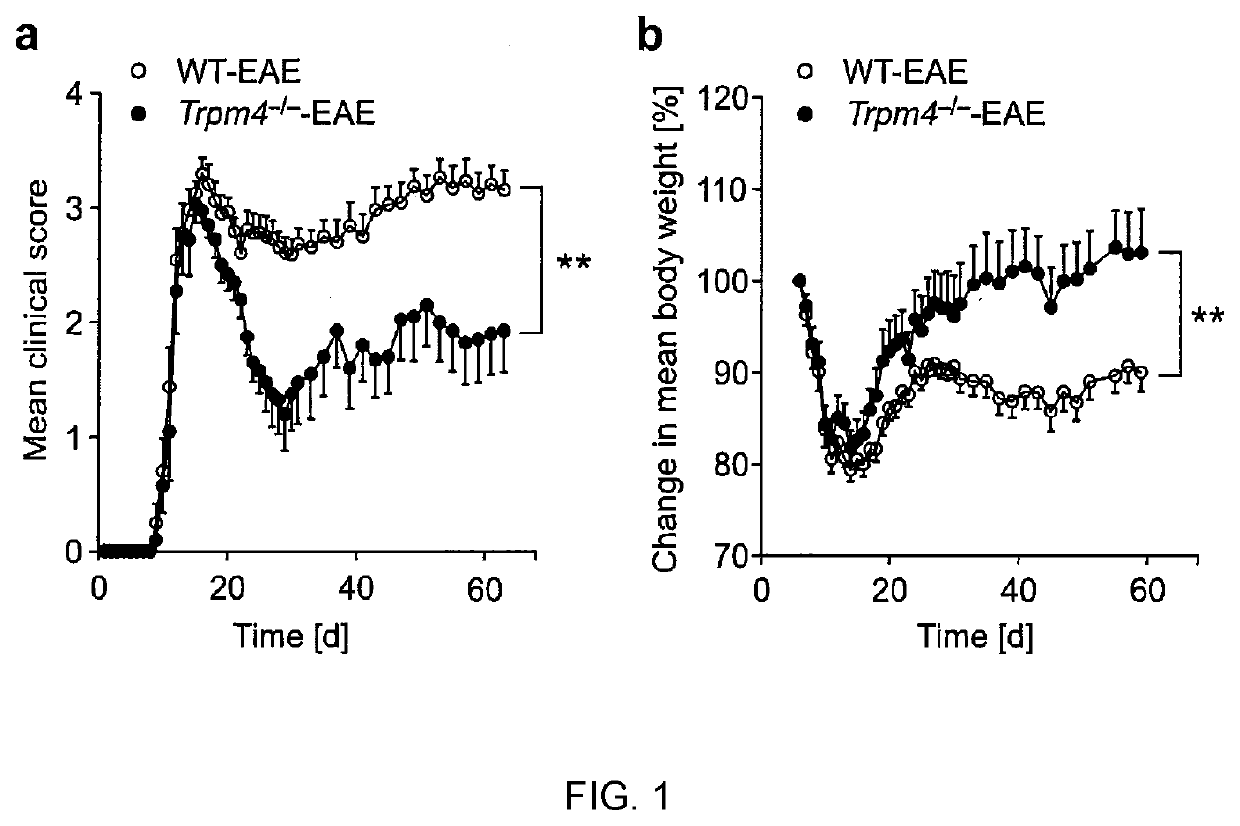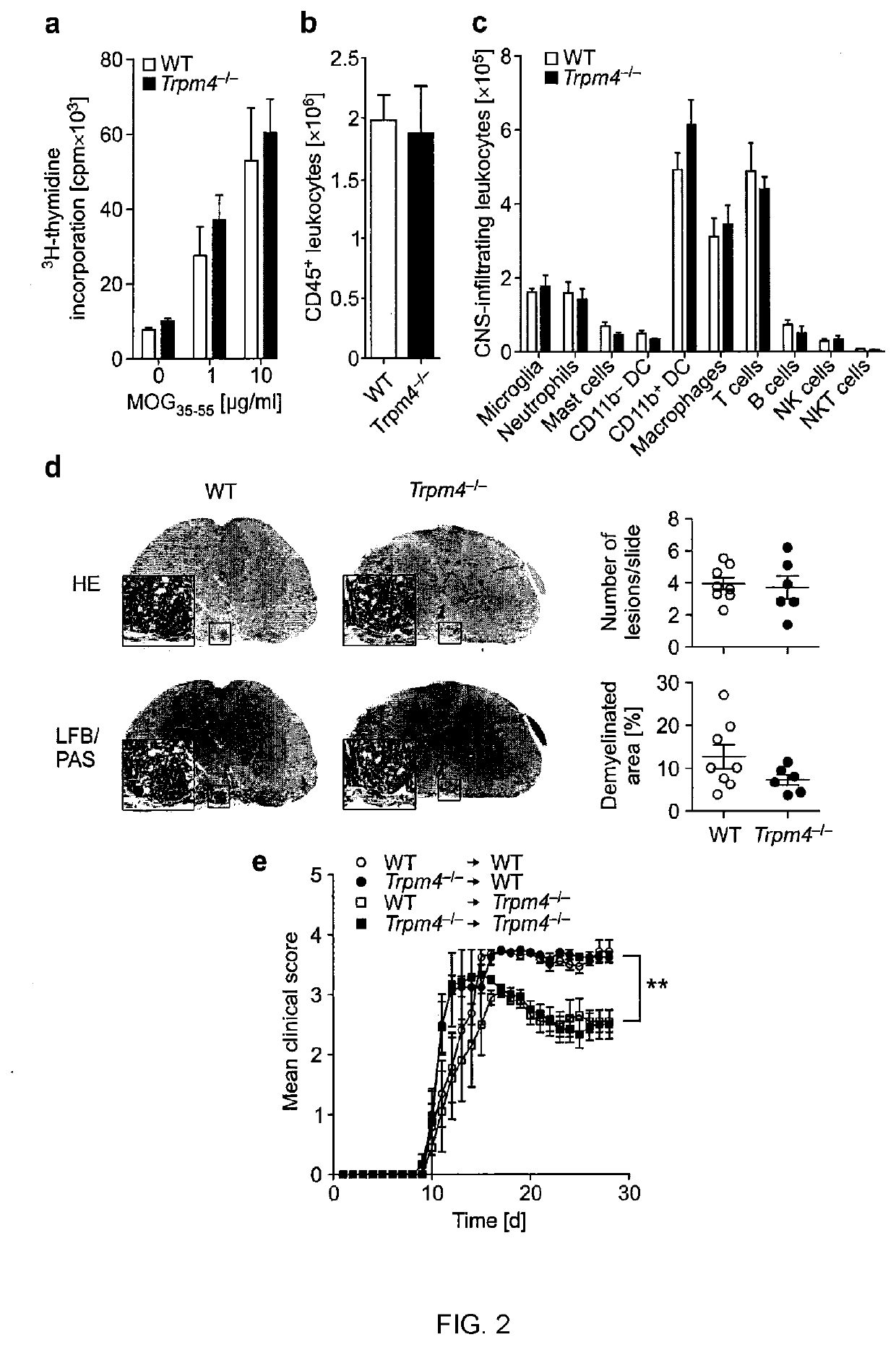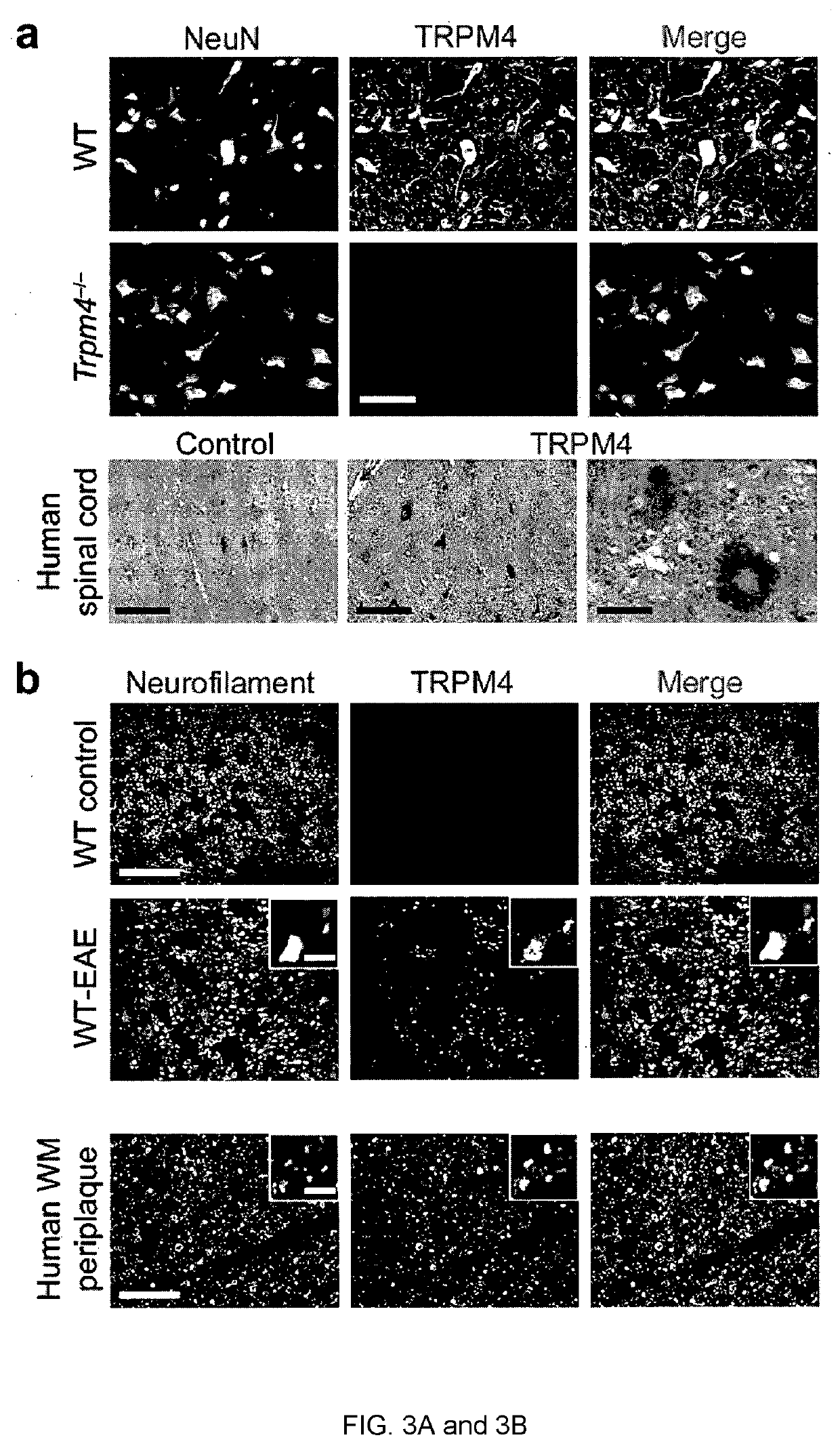Inhibitor of trpm-4 ion channel for treating or preventing neurodegeneration
a trpm4 ion channel and neurodegeneration technology, applied in the direction of instruments, drug compositions, amide active ingredients, etc., can solve the problems of no curative treatment available, the disease is only poorly understood to date, and the progressive loss of neuronal structure and function is particularly devastating to the affected patient and their family
- Summary
- Abstract
- Description
- Claims
- Application Information
AI Technical Summary
Benefits of technology
Problems solved by technology
Method used
Image
Examples
example 1
iciency Ameliorates Experimental Autoimmune Encephalomyelitis (EAE)
[0067]In order to investigate whether TRPM4 modulates the pathogenesis of EAE, knockout mice with a dysfunctional Trpm4 gene (Trpm4− / −) and wild-type (WT) mice were immunized with the myelin oligodendrocyte glycoprotein peptide 35-55 (MOG35-55) in order to induce EAE in these animals. The sequence of the MOG35-55 peptide used for immunization is shown in SEQ ID NO:3. Briefly, C57BL / 6 Trpm4− / − mice (Vennekens et al. (2007), Nat Immunol. 8: 312-320) and Trpm4+ / + littermates (referred to as WT controls) were immunized subcutaneously with 200 μg / mouse MOG35-55 in complete Freund's adjuvant (Sigma-Aldrich) containing 4 mg / ml Mycobacterium tuberculosis (H37Ra, Difco). In addition, 200 ng pertussis toxin (Calbiochem) was injected intravenously on the day of immunization and 48 h later. The mice were sex and age (6-10 weeks) matched and were scored for clinical signs every day over a period of 60 days by the following system...
example 3
of CNS Infiltrates by Flow Cytometry
[0071]Since the protective phenotype observed in Example 1 could not be explained by altered immune cell activation, CNS (brain and spinal cord) infiltrates were analyzed by flow cytometry. For the isolation of CNS-infiltrating immune cells, WT EAE (n=4) and Trpm4− / − EAE (n=3) mice were sacrificed by CO2 inhalation and immediately transcardially perfused with ice-cold PBS. Brain and spinal cord were removed, minced with blades and digested in collagenase / DNAseI solution (Roche) for 45 min at 37° C. Tissue was triturated through a 40 μm cell strainer. The homogenized tissue was washed in PBS (300×g, 10 min, and 4° C.). Immune cells including microglia were separated from myelin, other glia and neuronal cells by centrifugation over a discontinuous percoll (GE Healthcare) gradient. The homogenized tissue was resuspended in 30% isotonic percoll, transferred into a 15 ml Falcon tube and 78% isotonic percoll was layered underneath. The gradient was cent...
example 4
ow Chimeric Mice
[0073]Finally, bone marrow (BM) chimeric mice were established by reconstituting lethally irradiated Trpm4− / − or WT mice with bone marrow from either Trpm4− / − or WT mice. This was followed by an active EAE induction in these chimeras. Bone marrow chimeric mice were generated by lethal whole-body irradiation (9 Gy; 1 Gy / min) using a caesium-137 gamma irradiator (BIOBEAM 2000) of 5-6-week-old recipient WT and Trpm4− / − mice which were reconstituted 24 h later with 5×106 bone marrow cells derived from tibiae and femurs from respective donors. The lethally irradiated mice received bone marrow transplantations from either genotype (WT into Trpm4− / −, n=5; Trpm4− / − into Trpm4− / −, n=6; WT into WT, n=8; Trpm4− / − into WT, n=6). In addition to WT and Trpm4− / − cells, BM cells from CD45 congenic C57BL / 6 Ly5.1 mice (CD45.1) were transferred into irradiated C57BL / 6 WT mice (CD45.2) and assessed reconstitution (>95%) by FACS analysis of peripheral blood cells of mice 6 weeks after gr...
PUM
| Property | Measurement | Unit |
|---|---|---|
| conductance | aaaaa | aaaaa |
| molecular weight | aaaaa | aaaaa |
| molecular weight | aaaaa | aaaaa |
Abstract
Description
Claims
Application Information
 Login to View More
Login to View More - R&D
- Intellectual Property
- Life Sciences
- Materials
- Tech Scout
- Unparalleled Data Quality
- Higher Quality Content
- 60% Fewer Hallucinations
Browse by: Latest US Patents, China's latest patents, Technical Efficacy Thesaurus, Application Domain, Technology Topic, Popular Technical Reports.
© 2025 PatSnap. All rights reserved.Legal|Privacy policy|Modern Slavery Act Transparency Statement|Sitemap|About US| Contact US: help@patsnap.com



